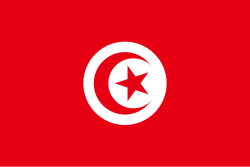Σημαία της Τυνησίας
Η εθνική σημαία της Τυνησίας υιοθετήθηκε για πρώτη φορά το 1831 από τον μπέη της Τυνησίας, Χασίν Α΄. Η ημισέληνος και το αστέρι αποτελούν παραδοσιακά σύμβολα του Ισλάμ και επίσης θεωρούνται σύμβολα καλοτυχίας. Τα σύμβολα αυτά υποδηλώνουν επίσης ότι η χώρα ήταν κάποτε τμήμα της Οθωμανικής Αυτοκρατορίας. Η σημαία, με το κόκκινο χρώμα ήταν η ίδια όταν η Τυνησία ήταν υπό οθωμανική κυριαρχία και επανακαθιερώθηκε έπειτα από την ανεξαρτησία της χώρας από τη Γαλλία.

 Λόγος σημαίας: 2:3
Λόγος σημαίας: 2:3Η Σημαία της Τυνησίας είναι κόκκινη και στο κέντρο φέρει λευκό δίσκο εντός του οποίου περιγράφεται κόκκινη ημισέληνος με το κυρτό μέρος προσίστια ενώ το κοίλο της περιβάλλει πεντάκτινο κόκκινο αστέρι. Ο λόγος πλάτους - μήκους είναι 2 προς 3.
Προηγούμενες σημαίες
Επεξεργασία
Παραπομπές
Επεξεργασία- ↑ Whitney Smith, The Flag Bulletin, no. 195, Sep.-Oct. 2000, pp. 171-194. "Another flag (Fig. 15), possibly introduced by Bey Hussein II, served on many occasions -- including the proclamation of the new Ottoman constitution on 21 March 1840. Referred to as the "state standard of the Regency," [footnote: Henri Hugon, "Les Emblèmes des beys de Tunis" (Paris: Leroux, 1913), p. 64] this flag was more than simply a personal banner of the ruler, although it appeared at ceremonies and visits in which the bey participated [footnote: Si Hassen Hosni Abdel-Wahab, "Note on the History of the Tunisian Flag" (Tunis, 1957), p. 3. The author claimed the standard was already three centuries old]). It was regularly used on the Bardo Palace, on the Citadel of Tunis, and on navy ships [footnote: Ibid and the captions of "Verzameling der Vlaggen by alle natien in gebruik" (Amsterdam, 1835-1850), a manuscript in the library of the Flag Research Center, illustration No. 37.]. ... The design of the standard [footnote: The flag --perhaps an elaborated version of the 1765 standard (...)-- as it appears in [smi75], p. 55, is an illustration from 1835 reproduced from the Verzameling.] varied somewhat over the years, but the basic elements were constant. (...) A simplified version of the standard (four stripes alternately green and red with sword of Ali overall in white) appeared on the white oval shield in the arms of the Regency, officially adopted in 1861 but in use earlier (Fig. 16) -- a rare example of a flag serving as the principal charge in the coat of arms of a country." (pp.185-186).
Αναφορές
Επεξεργασία- (Γαλλικά) Hugon, Henri (1913). Les Emblèmes des beys de Tunis: Etude sur les Signes de l'autonomie Husseinite. Paris: Leroux. σελ. 64. OCLC 962103.
- (Γαλλικά) Pierre C. Lux-Wurm· Martha Zaragoza (2001). Les drapeaux de l'islam: de Mahomet à nos jours. Paris: Buchet-Chastel. ISBN 2283018137. OCLC 48449213.